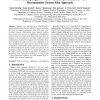Free Online Productivity Tools
i2Speak
i2Symbol
i2OCR
iTex2Img
iWeb2Print
iWeb2Shot
i2Type
iPdf2Split
iPdf2Merge
i2Bopomofo
i2Arabic
i2Style
i2Image
i2PDF
iLatex2Rtf
Sci2ools
DMIN
2009
2009
Understanding Support Vector Machine Classifications via a Recommender System-Like Approach
Support vector machines are a valuable tool for making classifications, but their black-box nature means that they lack the natural explanatory value that many other classifiers possess. Alternatively, many popular websites have shown recent success in explaining recommendations based on behavior of other users. Inspired by these ideas, we suggest two novel methods for providing insight into local classifications produced by a support vector machine. In the first, we report the support vectors most influential in the final classification for a particular test point. In the second, we determine which features of that test point would need to be altered (and by how much) in order to be placed on the separating surface between the two classifications. We call the latter technique "border classification." In addition to introducing these explanatory techniques, we also present a free-for-download software tool that enables users to visualize these insights graphically.
Related Content
| Added | 17 Feb 2011 |
| Updated | 17 Feb 2011 |
| Type | Journal |
| Year | 2009 |
| Where | DMIN |
| Authors | David Barbella, Sami Benzaid, Janara M. Christensen, Bret Jackson, X. Victor Qin, David R. Musicant |
Comments (0)

